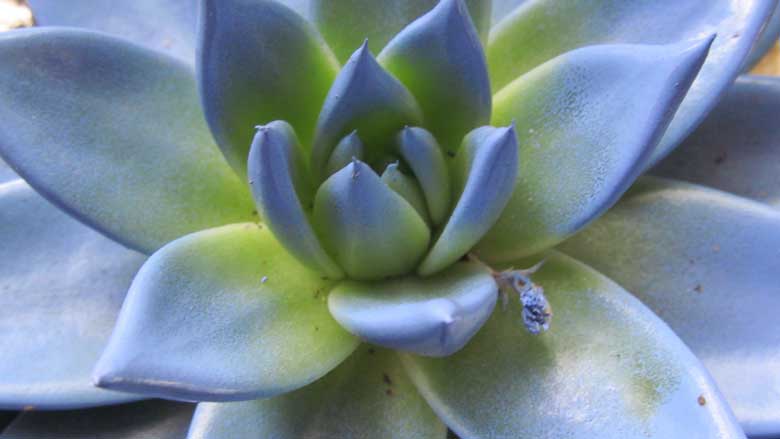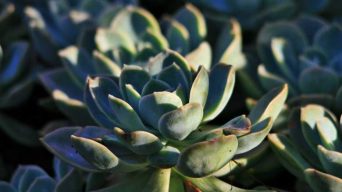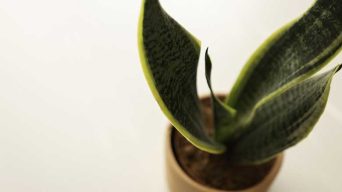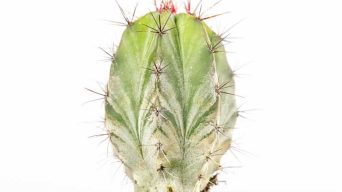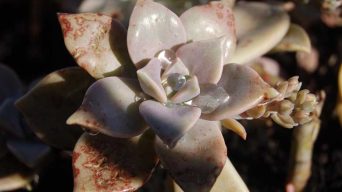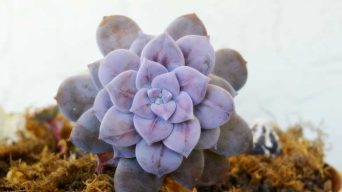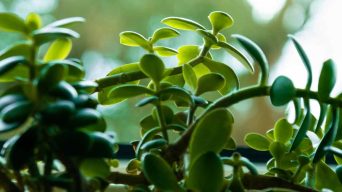White spots on succulents are not uncommon.
These white spots can be unsightly, and it’s important not to let them spread, or they will kill your plant!
There are many reasons white spots form, and we will discuss the most common causes and treatments in this article.
The good news is that white spot prevention is simple! You need to know how they form and what you can do about them when they appear.
What Causes White Spots on Succulents
There are many different reasons white spots can appear on your succulents.
You will want to make sure you can determine what the white spots are caused by before trying any kind of treatment.
Some white spots may be minor and not severe, while others could indicate a more severe issue.
Succulents white spots may be caused by:
Powdery Mildew
The white spots on succulents may be caused by powdery mildew.
Powdery mildew is a white fungus that can appear when there are high humidity levels and poor air circulation around your plants.
This white fungus will generally grow along the plant leaves but could also spread to other parts such as flowers, stems, buds, or roots.
Bacteria
Succulent white spots due to bacteria tend to look like they have been sprinkled with salt, which is where this type of white spot gets its name from (saltpeter).
The white buildup in these types of white spots tends to feel crusty when touched and can be in white, yellowish-brown, or gray colors.
This white buildup can also be on the roots of succulents as well.
Bacteria white spots tend to have a more severe effect on succulent plants, and if left untreated, this white spot could lead to your plant’s death.
Insects/Pests
Pests such as whiteflies, mealybugs, or aphids can also cause white spots on succulents.
These white pests will generally be found feeding around your plants’ leaves and flowers, which is where they get their nourishment from.
Pests such as whiteflies are particularly harmful to succulent plantings because these little guys excrete honeydew that enhances fungal growth, known for causing sooty mold, which prevents photosynthesis by blocking sunlight.
Fungus
White spots on succulents due to fungus are white and have a cottony or fuzzy texture.
Many different types of fungi can cause these white spots, so you will want to make sure that the white spot is not powdery mildew before trying any treatment for this type of white spot.
Fungi such as gray mold, leaf rot, rusts, blights, etc., can all cause white spots on your succulent plants, especially when there has been an increase in rain or humidity levels around your garden.
These fungal diseases will generally start from the bottom leaves working their way up towards the top of your plant’s foliage, causing it to wilt and die off if not treated immediately.
Natural Farina
Succulents white spots that appear white and have a flaky texture are caused by “natural farina”.
Some plants, such as cacti, produce this white substance on their leaves to help protect against harsh direct sunlight, water loss, and insect infestations.
The white farina substance will rub off easily on your fingers when touched.
Salt Damage
If you have ever found white spots on the lower leaves of succulent plants caused by excess watering, then this white spotting is known as “salt damage”.
This white buildup happens when there has been too much salt in the soil due to over-fertilizing or tap water with high mineral content, which can cause white buildup around leaf margins and tips.
If left untreated, these white marks could eventually turn brown and kill parts of your plant’s foliage, especially if it continues to be exposed to extra salty water through fertilizers or rain runoff.
Mineral Deposits
Succulents white spots caused by mineral deposits are white and can appear crusty or powdery.
These white buildup marks tend to be found on the fleshy leaves of succulent plants but could also show up on other parts such as flower petals, stems, buds, roots, etc.
This white substance is known to build up when there have been high concentrations of calcium carbonate, magnesium sulfate (Epsom salts), phosphate from fertilizers being absorbed into your plant’s foliage causing damage over time if not treated or removed correctly.
Natural Aging
Another type of white spot that can appear on succulents is a result of natural aging leaves.
As succulent leaves age, they will fade in color and eventually die off, which means it is normal to see white spotting appearing as these dead foliage starts to fall away.
This doesn’t mean you should ignore the white spotting even though this isn’t an issue for your succulent, but instead, remove those old leaves when they turn completely white so that new ones can grow in their place.
What Type of White Spot Might You Be Dealing With?
The best way to determine what type of white spot you might be dealing with is by performing an easy white spot test.
To do this white spot test, take a blade of grass and gently scrape the white buildup to see its color underneath.
If your white substance has turned brown, you are probably dealing with either fungus or salt damage, while if there are no colors other than white under the buildup, then powdery mildew might be causing your succulent white spots.
How To Treat White Spots on Succulents
To treat white spots on your succulent plants, first, make sure to quarantine the plant from others if you are dealing with white buildup caused by fungus or salt damage.
Next, remove all affected areas of white buildup using shears and clean pruners by cutting away any white buildup until there is only healthy green foliage left behind.
After this process is done, soak your entire infected plant in room temperature water for about 30 minutes.
Then, allow it to dry out entirely before repotting it into new planting soil so that no fungi can spread through root contact.
If powdery mildew was the culprit causing those pesky white marks on succulent plants, try making a baking soda & vinegar mix an organic fungicide solution as white buildup caused by powdery mildew shows up most on plants that are kept in moist and humid conditions.
You can also thoroughly clean any white spots away using the same process mentioned above for fungus or salt damage. After it is all clear, make sure to allow your succulents’ foliage some time to dry out before watering again.
When pests such as whiteflies, mealybugs, and spider mites cause white buildup on succulents, make sure to quarantine your plant from others as you did before during fungus or salt damage treatments.
Then you will need to spray white spots with an insecticidal soap which can be found at your local garden center and should kill off the pests.
Don’t forget to read all labels for accurate usage information before spraying, as too much of this organic pest control agent could burn succulent plants’ foliage.
If it turns out that white buildup on succulents is caused by natural aging, then there isn’t anything that needs to be done other than removing those white leaves when they turn completely white.
Once a year, however, try removing dead leaf portions throughout the spring and summer seasons, so new ones have room to grow in their place.
How To Prevent White Spots on Succulents?
The best way to prevent white spots from ever appearing is by making sure your succulent plants are given proper care.
Some things to consider to prevent white spots are:
Provide Bright Light
Succulents need bright light to grow their best, so ensure they are given plenty of natural sunlight for at least six hours per day.
White spots on succulents will appear if your plants are kept in the dark, humid conditions for too long, as white buildup is a sign of fungal or salt damage.
Provide Proper Watering
Succulents need the perfect amount of water to grow their best, so make sure you are watering them at least once every one or two weeks.
Only water succulents when the soil has dried out a bit and then soak them thoroughly until water runs through their drainage holes.
Never leave your succulent plant sitting in water as white spots will appear if it is too moist for too long.
Provide Well Draining Soil
Succulents need soil that drains well to grow their best, so ensure they are given a potting mix with proper aeration.
White spots on succulents will appear if your plants’ roots sit in water for too long, as this can cause fungus and salt damage.
Provide Proper Drainage
Ensure that your succulent planter has proper drainage holes in the bottom so water can easily run through when you are watering.
If white spots appear on succulents after they have been watered, make sure to check if their roots were sitting in standing water for too long, which could cause root rot or fungus.
Prune Properly
Succulents need to be appropriately pruned for new growth to appear. Such white spots on succulents will not have a chance of appearing.
Remove dead leaves and stems from your plant during the spring and summer seasons so it can regrow healthier green foliage throughout its life cycle.
Repot Regularly
Succulents need to be repotted regularly to keep them from becoming pot-bound, so white spots on succulents will not have a chance of appearing.
Repot your plant into a new container every two or three years or when the soil becomes too compacted.
Replace the old soil with fresh soil to prevent pests and diseases from invading your succulents.
Use Fertilizer Sparingly
Succulents need fertilizer sparingly. Only fertilize your plant during the growing season between spring and summer.
Make sure only to use organic fertilizer when fertilizing to avoid salt buildup from occurring.
Keep Them Clean
Succulents need to be kept clean to prevent white spots from appearing, so wipe down your plants with a damp cloth during the spring and summer seasons.
Keeping your succulents clean helps prevent white spot buildup, which will keep your plants looking healthy and beautiful.
Final Thoughts
White spots on succulents are a problem that many people have to deal with, but knowing the cause and prevention methods, white spot buildup can be kept from ever occurring.
Remember: white spots on succulents can be prevented by ensuring your plants are given proper care and that their environment is kept in an appropriate condition.
Succulents are low-maintenance plants that do not require much care, but this does not mean their care requirements are non-existent.
Knowing how to prevent white spots on succulents is a big part of keeping them healthy and full of life.

